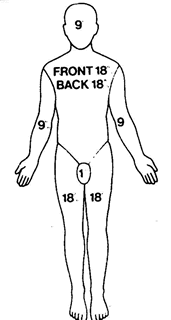|
BURNS; THERMAL INJURY Extremes in either heat or cold can damage the layers of the skin. Skin damage due to temperature extremes is called a Thermal Burn. Causes for thermal burns include: heat, flame, steam, hot water or frost bite. Burns disrupt the skin and alter the body's first line of defense against infection. Electrical shocks can travel through the inside of the body and cause very serious internal thermal injury. Burns are categorized according to their depth. Partial thickness burns (formerly called 1st Degree Burns) damage the epidermis. These superficial burns are very painful, but will generally heal with little intervention. Burns that involve the dermis will take a little longer to heal. These used to be called 2nd Degree Burns, but have now been subdivided into moderate partial thickness and deep partial thickness burns. Moderate partial thickness burns destroy the entire epidermia. Burns at this depth are red, painful and wet (e.g., with blisters). Epithelial cells that line the nerve routes and hair follicles preserve the ability to produce new skin cells. Deep partial thickness involve the blood vessels, producing a burn that has less fluid on the surface. These burns heal slowly, will leave scarring and are susceptible to infection. Full thickness burns are very deep, and have damaged tissue below the sweat glands, nerve endings and hair folicles. Consequently, these burns often apear dry and produce minimal pain. They are also below the level where new skin cells can be produced, therefore, skin grafts will be required. A section of healthy skin can be removed and placed over the burned area (called a skin graft). Skin grafts taken from another area of the patients own skin or from an identical twin will provide the cells that are required for new skin growth. In addition to determining the depth of the burns, the percentage of burned skin is calcualted using the Body Surface Area diagram (Image 2). |
Image 1: |
|
Image 2: |
|
|
|
|
|
Last Reviewed: October 23, 2014 |
|
|
|
Our masking guidelines have been updated. Visit the Patient and Visitor Masking Guidelines page for more information.





